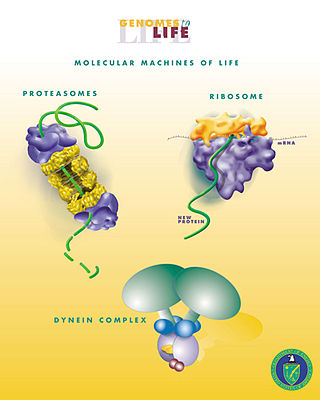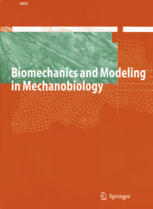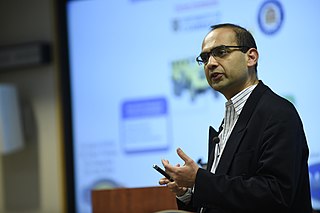
Biomechanics is the study of the structure, function and motion of the mechanical aspects of biological systems, at any level from whole organisms to organs, cells and cell organelles, using the methods of mechanics. Biomechanics is a branch of biophysics.

Soft tissue is all the tissue in the body that is not hardened by the processes of ossification or calcification such as bones and teeth. Soft tissue connects, surrounds or supports internal organs and bones, and includes muscle, tendons, ligaments, fat, fibrous tissue, lymph and blood vessels, fasciae, and synovial membranes.
Solid mechanics is the branch of continuum mechanics that studies the behavior of solid materials, especially their motion and deformation under the action of forces, temperature changes, phase changes, and other external or internal agents.
Yuan-Cheng "Bert" Fung was a Chinese-American bioengineer and writer. He is regarded as a founding figure of bioengineering, tissue engineering, and the "Founder of Modern Biomechanics".

Biological engineering or bioengineering is the application of principles of biology and the tools of engineering to create usable, tangible, economically viable products. Biological engineering employs knowledge and expertise from a number of pure and applied sciences, such as mass and heat transfer, kinetics, biocatalysts, biomechanics, bioinformatics, separation and purification processes, bioreactor design, surface science, fluid mechanics, thermodynamics, and polymer science. It is used in the design of medical devices, diagnostic equipment, biocompatible materials, renewable energy, ecological engineering, agricultural engineering, process engineering and catalysis, and other areas that improve the living standards of societies.
This is an alphabetical list of articles pertaining specifically to Engineering Science and Mechanics (ESM). For a broad overview of engineering, please see Engineering. For biographies please see List of engineers and Mechanicians.
Biomechanical engineering, also considered a subfield of mechanical engineering and biomedical engineering, combines principles of physics, biology, and engineering. Topics of interest in this field include biomechanics, computational mechanics, continuum mechanics, bioinstrumentation, design of implants and prostheses, etc. This is a highly multidisciplinary field, and engineers with such a background may enter related niche careers, e.g., as an ergonomics consultant, rehabilitation engineer, biomechanics researcher, and biomedical device engineer.

Kenneth Langstreth Johnson FRS FREng was a British engineer, Professor of Engineering at the University of Cambridge from 1977 to 1992 and a Fellow of Jesus College, Cambridge. Most of his research was in the areas of tribology and contact mechanics.

Biomechanics and Modeling in Mechanobiology (BMMB) is a bimonthly peer-reviewed scientific journal published by Springer Science+Business Media. The journal was established in June 2002 and is currently edited by Gerhard A. Holzapfel and David Nordsletten. It publishes research articles about theoretical, computational, and experimental studies in the fields of biomedical engineering, biomechanics, and mechanobiology.
FEBio(Finite Elements for Biomechanics) is a software package for finite element analysis and was specifically designed for applications in biomechanics and bioengineering. It was developed in collaboration with research groups from the University of Utah (MRL, SCI) and Columbia University (MBL).

Mark Andrew Miodownik is a British materials scientist, engineer, broadcaster and writer at University College London. Previously, he was the head of the Materials Research Group at King's College London, and a co-founder of Materials Library.
Mechanobiology is an emerging field of science at the interface of biology, engineering, chemistry and physics. It focuses on how physical forces and changes in the mechanical properties of cells and tissues contribute to development, cell differentiation, physiology, and disease. Mechanical forces are experienced and may be interpreted to give biological responses in cells. The movement of joints, compressive loads on the cartilage and bone during exercise, and shear pressure on the blood vessel during blood circulation are all examples of mechanical forces in human tissues. A major challenge in the field is understanding mechanotransduction—the molecular mechanisms by which cells sense and respond to mechanical signals. While medicine has typically looked for the genetic and biochemical basis of disease, advances in mechanobiology suggest that changes in cell mechanics, extracellular matrix structure, or mechanotransduction may contribute to the development of many diseases, including atherosclerosis, fibrosis, asthma, osteoporosis, heart failure, and cancer. There is also a strong mechanical basis for many generalized medical disabilities, such as lower back pain, foot and postural injury, deformity, and irritable bowel syndrome.

Marco Amabili is a professor who holds the Canada Research Chair in Vibrations and Fluid-Structure Interaction, Department of Mechanical Engineering at McGill University, Montreal, Québec, Canada.
The William Prager Medal is an award given annually by the Society of Engineering Science (SES) to an individual for "outstanding research contributions in either theoretical or experimental Solid Mechanics or both". This medal was established in 1983. The actual award is a medal with William Prager's likeness on one side and an honorarium of US$2000.
Raymond William Ogden is a British applied mathematician. He is the George Sinclair Professor of Mathematics at the Department of Mathematics and Statistics of the University of Glasgow.
Caitríona Lally is a professor of Bioengineering in Trinity College, Dublin. She has been a qualified mechanical engineer since 1997. She did a PhD in cardiovascular biomechanics.
A number of processes of surface growth in areas ranging from mechanics of growing gravitational bodies through propagating fronts of phase transitions, epitaxial growth of nanostructures and 3D printing, growth of plants, and cell mobility require non-Euclidean description because of incompatibility of boundary conditions and different mechanisms of developing stresses at interfaces. Indeed, these mechanisms result in the curving of initially flat elements of the body and changing separation between different elements of it. Gradual accumulation of deformations under the influx of accumulating mass results in the memory-conscious grows of the body and makes strains the subject of long-range forces. As a result of all above factors, generic non-Euclidean growth is described in terms of Riemannian geometry with a space- and time-dependent curvature.

Alain Goriely is a Belgian mathematician, currently holding the statutory professorship (chair) of mathematical modelling at the University of Oxford, Mathematical Institute. He is director of the Oxford Centre for Industrial Mathematics (OCIAM), of the International Brain and Mechanics Lab (IBMTL) and Professorial Fellow at St Catherine's College, Oxford. At the Mathematical Institute, he was the director of external relations and public engagement, from 2013 until 2022, initiating the Oxford Mathematics series of public lectures. In 2022, he was elected to the Royal Society.

Vikram Sudhir Deshpande,, is an Indian-born British engineer and materials scientist, currently Professor of Materials Engineering in the Department of Engineering at the University of Cambridge.
Andrew Biewener is the Charles P. Lyman Professor of Biology in the Department of Organismic and Evolutionary Biology at Harvard University and Faculty Director of the Concord Field Station. He is also a Fellow of the American Association for the Advancement of Science.









